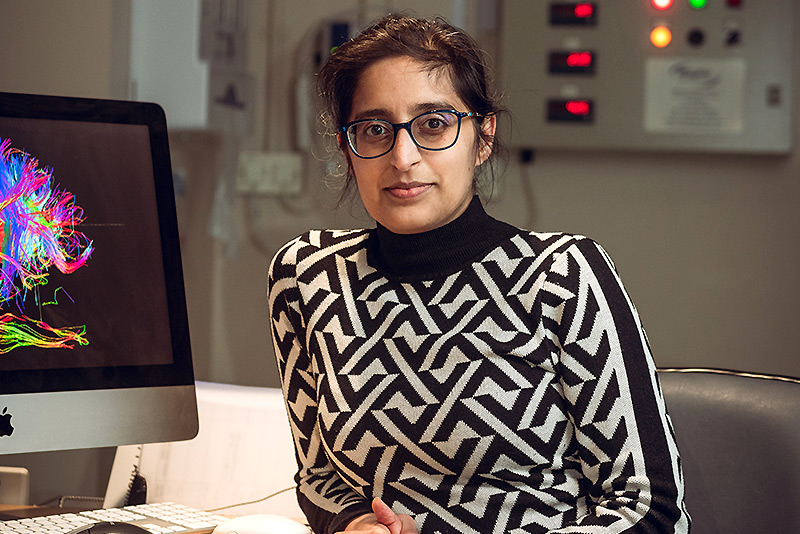A legacy gift is helping to drive forward vital research into the UK’s biggest cause of sight loss: macular disease.
Just 5mm across, the macula is a tiny but critically important part of the retina, responsible for all of our central vision, most of our colour vision and our ability to see in fine detail. Damage to this area of the eye can have a dramatic impact on sight, leaving those affected unable to read, drive and recognise faces.
Nearly 1.5 million people in the UK have a condition that affects the macula, known more broadly as macular disease. The most common form is age-related macular degeneration, but there are also a large number of rare, inherited conditions called macular dystrophies. It is this latter category that particularly interests Dr Jasleen Jolly, Senior Clinical Research Fellow in the Nuffield Department of Clinical Neurosciences (NDCN).
Two years ago, Dr Jolly launched a study to investigate the structure and function of the brain’s response to Stargardt disease, the most common form of juvenile macular dystrophy. Through the study she hopes to determine how the visual brain of patients with this genetic disease differs from people with healthy visual systems, as well as those with an inherited retinal condition that spares the macula, called Choroideremia.
‘Traditionally we’ve thought that the retina impacts the retina and then that’s it. But actually, everything is interconnected,’ says Dr Jolly. ‘To see, you need not only the eye to work, but you also need those signals to be processed properly in the brain. The question is: when you get changes in the input to the brain, does that change the way that the brain actually processes that information?’
Dr Jolly is working with patients from across the disease spectrum to find out. Participants undergo five different types of brain imaging during their visits to her research clinic, as well as hearing tests, retinal scans and visual function tests. It is the first time in the world a study has combined – in the same individuals – data from vision, the retina and the visual pathway in the brain.
This novel approach will allow Dr Jolly to model how the visual system alters in response to disease – information that will play a crucial role in the development of treatments. ‘Gene therapy is complicated in Stargardt disease; because it’s such a big gene, it doesn’t fit into the mechanism that we usually use,’ she explains. ‘That’s why it’s so important to understand as much as we can about the disease now, so that when we get to the clinical trials, we’re able to use the most appropriate measures.’

Eventually, Dr Jolly hopes her work will contribute towards the development of a therapy that does not depend on the underlying cause of vision loss and can complement treatment of the retina. ‘The brain is constantly making new connections or changing its connections depending on what we’re doing. When we learn a new language, for example, we’re making new connections,’ she explains. ‘So, if we can harness the power of the brain, we could potentially help people to make the most of the vision they’ve got left.’
Dr Jolly’s is one of four cutting-edge studies taking place in the NDCN thanks to a legacy gift left by Jean Williams, who died in 2017 at the age of 96. Jean was diagnosed with inherited macular dystrophy as a child and chose to leave a portion of her estate to fund research into macular disease.
Postdoctoral scientist Dr Jing Yu is leading another of these studies. Working alongside Professor of Ophthalmology Susan Downes, he is hoping to identify genetic variants that may predispose individuals to hydroxychloroquine (HCQ) macular retinal toxicity.
HCQ is a drug widely used for inflammatory conditions, however in some patients its use can result in irreversible central vision loss. ‘Because the drug is so good it’s the first line of treatment for many conditions, and apart from the retinal toxicity it doesn’t have many bad side effects,’ explains Dr Yu. ‘But once the toxicity is there, it can’t be cured.’
By putting all of the information we’re gathering together, we can delve in a lot deeper than anyone else has done
To minimise the risk, regular retinal screening is recommended in the UK, however, this is expensive – costing approximately £10 million per year – and can only identify toxicity after it has started. If Dr Yu is able to find genetic markers linked to an increased risk of developing the condition, HCQ use can be avoided in that group, protecting their vision and reducing the need for regular screening.
Boosted by Jean Williams’ gift, Dr Yu is on track to enrol over 600 participants in the study, making it the largest of its kind in the world. ‘We want as many HCQ users to benefit as possible,’ he says. ‘And then people who use the drug will be reassured that their risk of developing this kind of sight problem is very low.’
Improving the outcome for patients is also what drives Dr Jolly forward. ‘Because Stargardt disease starts quite early on in life, it has a big impact – a lifelong impact,’ she says. ‘It’s good to be able to give people hope, to let them know that we are thinking about them and trying to support them.’
Providing this support is not without challenges though. Vision currently accounts for just 1% of the UK’s research budget, and it is decreasing due to the pandemic. ‘If you wanted to reflect how much of the NHS’s work is devoted to sight, we should be around 20% of funding,’ says Dr Jolly. ‘It’s a really exciting time for vision because there have been so many advancements in therapies, but if we don’t do the background work, we can’t move forward with them.
‘That’s really why gifts like this are so critical.’
Find out more about leaving a legacy